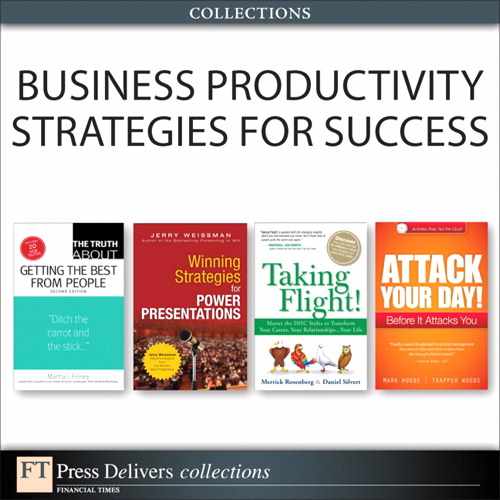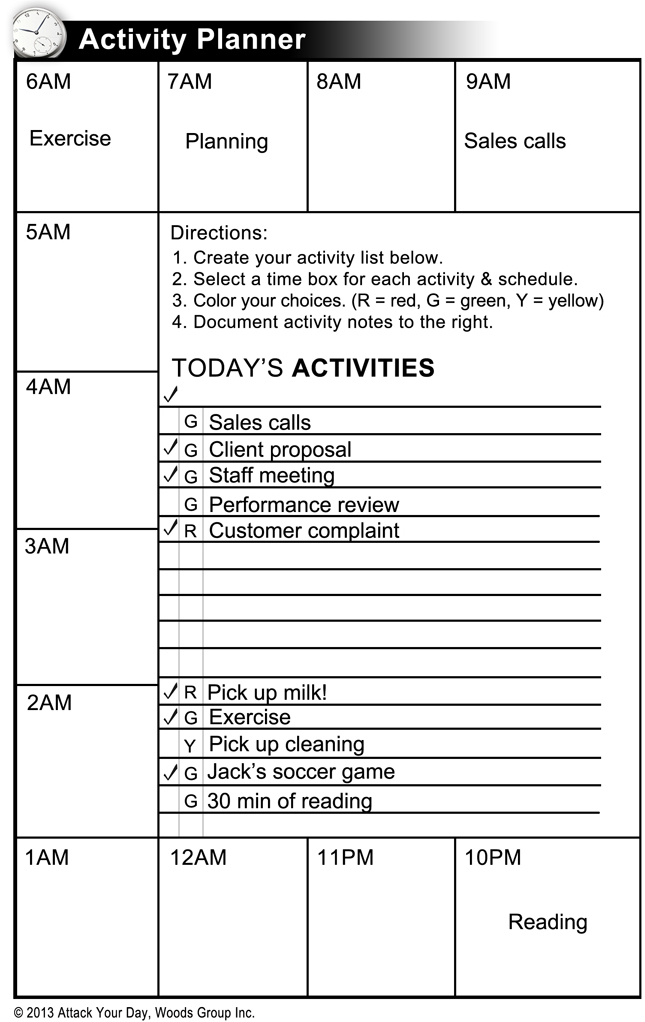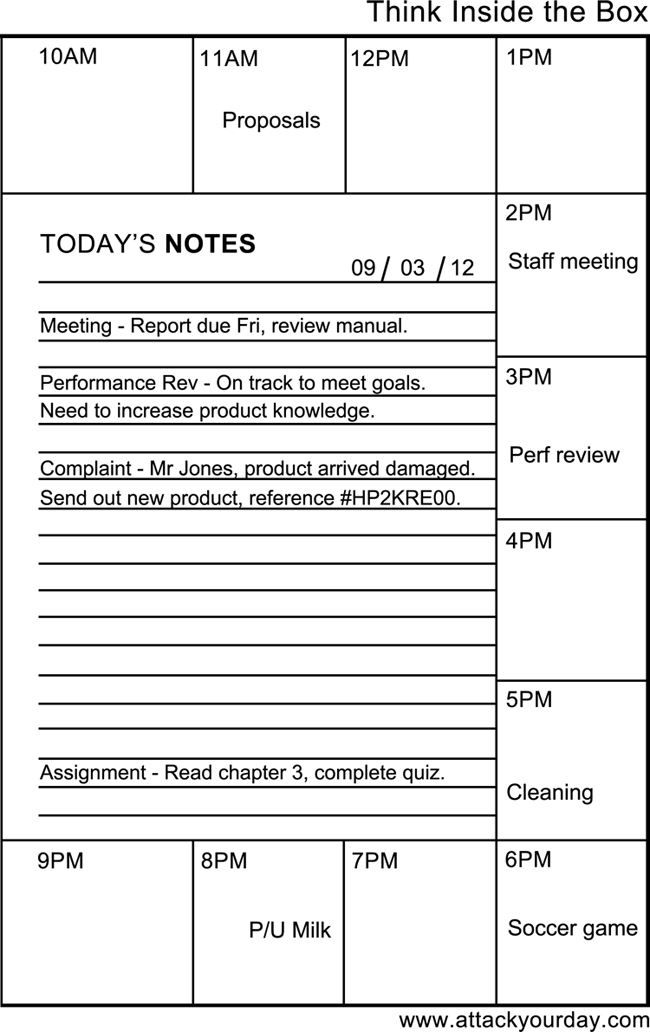Chapter 4. Arrange Your Plate
Think Inside the Box
The old way of thinking has been to place emphasis on the linear nature of time. Digital clocks blink away our life from the past to the present to the future. Often we find ourselves racing against time lines. It reminds us of the old saying, “The hurrier I go, the behinder I get.”
What if we think of time as space? Time is the space in which we live. Just as a box is a space we fill with goods, an hour is a “time box” we fill with activities. Looking at time as space makes it easier to manage.
When we begin to look at an hour as a space in which we will execute activities, we are forced to be more realistic when we plan. A box—whether it’s cardboard or time—can only hold so much.
We think most people intuitively recognize time as space. They refer to their day as a plate, which is limiting and they have too much on it. Furthermore, they don’t seem to know what to do about it. Yet, each day a new miracle occurs—we are given a fresh plate consisting of 24 spaces of time called hours, into which we can pack any activities we choose.
We are so committed to treating time as space that we felt the need for a new planner design—a design that would provide 24 “daily miracle time boxes” that followed the revolution of a board game and would help us visualize time as space (see Figure 4.1 and Figure 4.2). You can download a PDF sample of this planner design at our website www.attackyourday.com. We suggest you use the activity planner for one week. When you get really good at it, you can apply the technique “time as space” to whatever tool you use, paper or electronic.
Figure 4.1. The Activity Planner, left side (©Woods Group Inc. and © Day-Timer, Inc.)
Figure 4.2. The Activity Planner, right side (©Woods Group Inc. and © Day-Timer, Inc.)
So what activities are on your plate today? Did you take some time to arrange your plate? Or do you let others come along and throw their stuff on your plate? The too-much-on-my-plate challenge cannot be resolved without developing a simple and enjoyable ritual. That ritual is to make a daily appointment with yourself to arrange your activities for the day. Call it planning if you like, but we prefer the term arranging.
I sometimes ask people if they plan their day. Often they respond by saying, “Sure, here’s my list.” But making a list isn’t planning. Everyone is running around with lists. We agree with the British humorist who said, “The only important question in life is: What will I do next?”
Planning in advance will help you determine what you’ll do next as you arrange the order for accomplishing the activities on your list. The challenge is that our most important resource—our time—is limited. As we mentioned earlier, each day we have 24 time spaces. Each of these time spaces of opportunity consists of one hour or 60 minutes. How well do you do fill your time spaces?
Here’s the challenge: How do you arrange all the activities on your plate so they fit into your 24 hours? In addition, how do you make room in these time spaces for the expected/unexpected? How do you arrange the activities on your plate in a way that strikes a balance between self, family, work, and service responsibilities? And finally, as you execute activities around the clock, how do you manage your personal energy?
I think we would all agree the arranging challenge can be daunting. That’s why so many people don’t face it head on. However, investing no time in arranging your day leaves you more vulnerable to interruptions, distractions, and general chaos.
You will be less vulnerable to interruptions and distractions if you are good at applying the second key skill of activity management: the ability to arrange activities; in other words, managing what’s on your plate.
Most people face each new day with two big questions looming over them. The first question each day is this: “What’s on my plate today?” The second question is, “How in the world will I get all of these activities done?” The solution lies in a concept we discussed earlier, that of making an appointment with yourself each day where you take time to arrange what’s on your plate.
It’s been our experience that most people only take 1 to 5 minutes each day to do this. It reminds me of an old expression my mother used when I was a young boy. After cleaning the house she would sometimes say, “I just gave it a lick and a promise.” Have you ever heard that expression? Even as a young boy, I could figure out that it meant she hadn’t taken much time, that she hadn’t been very thorough, and that she didn’t do it very well.
When people only give their planning time a “lick and a promise,” they are usually frustrated, out of control, and their day controls them rather than the other way around.
There are so many issues to consider while arranging that it is impossible to do it in 1 or 2 minutes. Some of the things you need to consider are
• Arranging creative activities during the time of day you are most creative.
• Arranging for availability with others when input is required.
• Arranging time to isolate yourself from others so you can focus on high priorities.
• Arranging time to manage your energy.
• Considering the schedules of family members and arranging time for them.
• Considering how you will arrange time to deal with the expected/unexpected. (This is an oxymoron that makes sense.)
When you stop to think about all these things, it becomes clear why time management is hard for most people instead of ridiculously easy. It’s hard because people don’t take the time to arrange their day.
Because You’re Worth It
If you want time management to be easy, you need to “take-it-easy” for 30 minutes by yourself every day. Be a “lone arranger” and let your mind, your subconscious, and your heart guide you.
Let’s discuss the process of arranging the day. It’s not only an enjoyable experience, but it can increase your effectiveness exponentially. You’ll also discover it can help you reduce stress. The resources you’ll need to arrange your day are
• 30 minutes
• A best time
• Your time management tools
Let’s begin with resource number one, a place where you can be alone to plan. This place needs to be away from any noise or distractions that apply to you. It also needs to be a place where you can sit, think, and write. These criteria eliminate your shower because, while a shower is a great place to think, it is a lousy place to write. The criteria also eliminate your car while you are driving or riding with somebody else.
A final word about your special alone place is that you’ll find it works best if you use it consistently as the place where you plan/arrange. Think of this as your space-place. It’s great to have some space in a place you can be alone for a while.
Resource number two is 30 minutes each day reserved for arranging time. Why 30 minutes? A planning/arranging advantage seldom talked about is this important concept—when planning is not rushed, your subconscious mind and your heart have a chance to engage and assist you with the planning process.
Your subconscious mind will feed to you considerations you might otherwise overlook. It will give you a chance to evaluate with your heart the plans you’ve made for the day. When you do this—listen for intuitive promptings and follow them—it is likely that you will make better decisions.
Thirty minutes also benefits you in other ways. It gives you a chance to take a deep breath and reduce your stress. You will feel more in control, and you will be more in control.
Five Times the Outcome
Depending on the nature of your tasks, some will require more than 30 minutes to plan. Maybe that makes you even more nervous about setting aside sufficient time to plan. Consider this old axiom, “For every minute you plan/arrange, you get three times the execution.” In our opinion, that’s conservative. We believe that for every minute we plan, we can actually get five times the execution. You can, too.
There is nothing more crucial in activity management than taking 30 minutes each day for arranging the order for accomplishing activities. It pays huge dividends.
Sadly, for many, it never happens because of the big lie some people tell themselves. The one that goes like this: “I don’t have time to plan/arrange today!” Isn’t that the very reason they need to plan? Everybody has time to plan. If they don’t plan/arrange, then “lack of planning” or “lack of arranging” becomes their plan. This is a negative, hazardous habit. It is hazardous to your health because, without a plan, stress is increased. It is hazardous to your work-life balance because, without careful planning and purposeful arranging, personal life and family life suffer. It is hazardous to your career because without planning/arranging you operate less efficiently than you could. All of these hazards make time management tough instead of ridiculously easy.
Don’t cheat yourself. This is the fastest way to get attacked. Set aside sufficient time daily for you and attack your day. Yes, YOU. It is time for you to slow the pace; time for you to be isolated from chaos; time for you to activate a friend and partner called your subconscious and to engage your heart.
Resource number three is a best time for you to arrange your day. What do we mean by a best time? Some of us are morning people and others of us are night people. If you are a morning person, then set aside time in the morning to plan/arrange. If evening would be a better time for you to plan the upcoming day, then that’s when you should do it.
Just remember, the best time to plan is connected to when your best place is available. As we’ve already mentioned, this place is a place of solitude, totally free of interruptions and distractions. At first, some people think such a place does not exist. With some creativity and a desire to find such a place, almost everyone can.
Resource number four is your time management tool(s) of choice. The specifics of those tools were discussed in Chapter 2, “Color Your Choices: The Art of Choosing and Refusing,” where you were advised to use the tool or combinations of tools that serve you best. As a reminder, the resources you’ll need to arrange your day are
• 30 minutes reserved for planning/arranging time
• A best time of day for you to plan
• Your time management tools
You are now ready to arrange your day, and it’s as easy as one, two, three! Practice these three easy steps each day during your 30 minutes of alone time. If you do, you’ll have the assurance nothing will fall through the cracks. Also, your ability to accomplish value-added activities should increase substantially.
Easy as One, Two, Three
Step One: Decide which activities to put on your plate for today. If you look at everything on your plate as though it has the same value, the day seems overwhelming and intimidating. On the other hand, if you look at what’s on your plate through the metaphor of the traffic light, it is not as overwhelming. You see activities for what they are in terms of payoff: red, green, yellow, and gray.
But wait! How do you decide what to put on your plate in the first place? I’m talking about activities other than the ones that are tossed on your plate by others.
It’s simple. During the 30 minutes you are spending on alone time in your space place, simply check each of the buckets. Then move the activities you want to accomplish today into today’s bucket, bucket three. We suggest a routine in the following order:
1. Check bucket one, your monthly calendar. Move any scheduled commitments on your calendar for today into the appointments section of today’s bucket three.
2. Next, look in bucket two, your catch-all bucket. At this point, aren’t you pleased you have a catch-all bucket where you’ve centralized all the odds and ends you need to worry about rather than searching for little pieces of paper and notes written on almost anything? Scan your catch-all bucket and you may see, for example, a reminder to buy a wedding gift for a friend. Move that activity into the daily bucket, “buy gift.” Remember, a catch-all bucket isn’t going to be much help unless you look into it every day and move activities into bucket three in a timely way. Isn’t this easy?
3. Now take a peek at yesterday’s bucket three. If there is any activity remaining there that was not completed, move it into today’s bucket three. For example, if you didn’t finish your expense report yesterday, put it on your activity list for today.
4. Then take a look at bucket four, the memory bucket, for yesterday. If you documented something that requires follow-up action, you can move it to today’s activity list. Perhaps such an activity could be a commitment to fax an associate a report, or, if there is no rush, you can drop it in your catch-all bucket where it will not be forgotten.
5. Where do you go next? Check your information bucket, where you carry your planned future outcomes, your goals. Perhaps you have planned a summer vacation to Europe. Decide on an activity you could do today such as “order brochures.” Doing that activity will move you forward on your vacation activity path. Executing goal-related activities each day speeds you along toward the outcomes you desire.
6. Next, check your communication bucket, voicemail, and email. It’s my personal preference to check voicemail first. If there is a serious emergency, a red activity, it’s more likely to come by voicemail rather than email. Let’s assume there is a call from Elizabeth Jones. Add that to your activity list and delete it from your message center. Simple. The fact that it’s on your action list reduces the likelihood you will forget to make the call.
Now to the minefield called email. Yes, it’s a great innovation, but one that, unfortunately, is abused by many. More people are knocked off track by email than anything else. Email is like having 50 to 100 people lined up outside the door, not in any order, and you allow each one to poke his or her head in your office door and take some of your time to tell you something.
Many people allow others to intrude via email when they wouldn’t stand for it if they were physically outside their door, yet the amount of time wasted is just the same. Here’s the point—don’t get side tracked by heavy email traffic while you are arranging your day.
Use the traffic light metaphor to speed through your email congestion. Pick out the red events/activities that require your immediate attention and move those to the action list in bucket three. Set aside a time to come back later to answer and sort out the greens and yellows. Of course, develop a delete button trigger finger for the grays.
You can see what you’ve put on your plate in the form of a list of planned activities. The sources for these activities were

When you have a bucket to hold everything and everything is in its bucket, and you check each bucket daily, nothing falls through the cracks. Not only is this easy, think of the peace of mind you will have. This process allows you to be like Albert Einstein, who said, “I never try to remember anything. I just write it down and know where to find it.”
Okay. You’ve checked each tracking bucket as sources for building a list of activities to put on your plate for the day. That means you’ve completed step one in arranging activities. Arranging your day truly is as easy as one, two, three. Let’s consider step two.
Step Two: In step two, you place a value on each activity to facilitate better choice making. It’s easy. Remember the traffic light and decide which activities are red, green, or yellow. Simply put the letter of the corresponding color in front of each activity. For example, R = Red, G = Green, and Y = Yellow.
Coding activities by color/value is how you get a perspective of your activities at the start of each day. Sometimes the colors can change as the context of the work environment changes. I call this chameleon prioritization. A chameleon changes color with the environment.
For example, a green activity can change to red, or a yellow activity to green if some unexpected event suddenly shifts your priorities.
What’s on Your Plate Today?
If you are looking at your plate like the one in Figure 4.3, so that every one of those black dots represents an activity you must perform, that’s pretty intimidating. Most people look at their plate that way.
Figure 4.3. Your activity plate
But you and I, we don’t have that problem anymore. All we have to do is color our choices. In Figure 4.4 we look at our plate in color; each activity becomes red, green, or yellow.
Figure 4.4. Your activity plate in color (or in shades of gray, as done here)
For Best Results
For best results, the activities on your list should be primarily green. This is so important that I want to really emphasize it, so I’ll say it again. For best results, the activities on your list should be primarily green. Green activities keep you on the activity path to achieve your desired outcomes. Again, just remember to do what your mother always said, “Eat your greens.” Remember, green means go there. Go with the green as much as possible.
Step Three: Now on to step three in arranging your day. What needs to be considered here is when, where, and how you plan to accomplish the activities. While it is true your day will probably not materialize the way you initially arrange it, it will provide you with a strategy to use for negotiating with changes as the day requires it.
There are five friendly planning/arranging guides that can assist you in arranging your day. Let me introduce them to you. They are
• Necessity
• Reality
• Practicality
• Efficiency
• Spontaneity
Let’s see how these key words help you as you consider what’s on your plate.
Necessity: First ask, “What things are absolute necessities today?” Then schedule the actual time you plan to do the necessities as an appointment with yourself. Do necessities as early in the day as possible.
Reality: Next ask, “Am I in touch with reality?” Remember: Things always take longer than you think. A lot longer. So allow at least 20 percent more time to accomplish the activities than you think it will take. Also, decide what time of day, in which time box, you will accomplish each activity on your plate. Give each green activity a space of time. When you schedule the time you plan to do things, it will help keep you in touch with reality.
Practicality: Next ask, “What’s the most practical way to do these activities?” Plan time away from the chaos of the day to do vital, value-added activities. Also, group similar projects together. For example, if you have a certain amount of corresponding to do, do it all at once. Studies show when people “batch” activities they are more effective.
Efficiency: Now ask, “What’s the most efficient way to get these activities done?” Consider what things on your plate can be delegated and do it. Match activities that require the most mental and physical effort with the times of day your energy reserves are highest.
Spontaneity: Finally, ask yourself, “How much time should I reserve for the expected/unexpected?” Always expect the unexpected. Never fill your plate totally. Always save some time to handle the pop-ups.
As you listen to these five planning guides with your intuitive ears, you’ll be amazed at how well your days begin to work for you.
Be consistent in setting aside some time alone each day to go through the foregoing steps. Day after day, week after week, and month after month, you’ll get better and better at activity arranging.
Remember, the ridiculously easy one, two, three steps are
Step 1: Decide what activities to put on your plate.
Step 2: Place a value, a color value, on each activity.
Step 3: Use the planning guides to help you decide when, where, and how to accomplish the activities.




